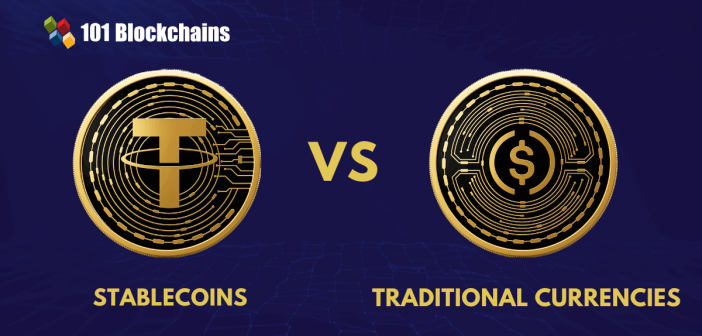Master stability in a volatile world — unlock the power of stablecoins to navigate crypto with confidence. Explore real-world use cases in the Stablecoins Mastery course.

- Comparisons
Georgia Weston
- on April 14, 2025
Stablecoins vs. Traditional Currencies: Which Is the Future?
Traditional currencies have dominated the financial landscape for a long time. However, in recent years, a new type of digital currency has emerged, called stablecoins. Although Stablecoins are a novel concept, they hold immense promise in today’s financial landscape. In fact, Sablecoins today serve as a bridge between traditional currencies and cryptocurrencies. In the evolving financial landscape, it is essential to understand what Stablecoins are. Additionally, you should be able to answer the question, “How are stablecoins different from traditional assets?’ Let’s take a look at the current financial landscape by exploring Stablecoins vs traditional currencies.
Build your identity as a certified blockchain expert with 101 Blockchains’ Blockchain Certifications designed to provide enhanced career prospects.
What are Stablecoins?
Stablecoins are certainly among the most popular crypto assets today. These cryptocurrencies are programmable virtual currencies generally pegged 1:1 to fiat currencies like the USD. Unlike other digital currencies, which can be highly volatile, stablecoins remain stable. Their consistent value makes them highly attractive today. Some unique features of stablecoins you should know include:
- Stablecoins are digital currencies, and they are tied to fiat currencies, ensuring their value remains stable or consistent.
- Since blockchain technology powers these currencies, they act as a highly secure, efficient, and flexible medium of exchange.
- Users can engage in faster and highly efficient transactions by using Stablecoins since they have a virtual existence.
What are Traditional Currencies?
Traditional currencies are also known as fiat currencies. These currencies are issued by national governments and derive their value from public trust in the issuing authority. For centuries, traditional currencies have played a crucial role in the financial system. People use these currencies as the primary medium of exchange. Each country has its own currency for financial transactions. Key features of traditional currencies include:
- Traditional currencies are highly centralized in nature, and they are regulated by the respective issuing regions.
- These currencies act as the main tools used by central banks to influence interest rates and inflation.
- During financial instability, traditional currencies help stabilize nations’ economies.
Master the future of digital finance! Gain practical fluency in integrating stablecoins with DeFi platforms, smart contracts, crypto wallets, and cross-border payments in the Stablecoins Mastery Course.
Major Differences Between Stablecoins and Traditional Currencies
Both stablecoins and traditional currencies act as currencies. However, they are very different from one another. As you already have an insight into Stablecoins and Traditional Currencies, it is time to look at their differences. By understanding how they vary from each other, you can gain insight into the future of the financial realm. The main differences between these currencies are presented below:
-
Technology
When discussing traditional currencies vs stablecoins one of the main differences is undoubtedly related to technology. The role of technology, especially blockchain technology, is fundamental in the case of stablecoins. Blockchain technology ensures flexibility, security, and transparency in stablecoins. Thus, you could certainly say that technology acts as the backbone of these digital currencies.
When it comes to traditional currencies, the role of technology is limited. On the contrary, banking systems play a pivotal role in supporting these traditional assets. In the absence of banks, traditional currencies cannot exist. However, you cannot ignore the role of technology in the context of traditional currencies. This is evident in the rising popularity of cashless transactions and online payments.
-
Role of a central authority
Stablecoins may be centralized or decentralized. Some of the common examples of centralized stablecoins are USDA and TrueUSD. In addition to centralized stablecoins, there exist several examples of decentralized stablecoins, such as DAI and FRAX. Therefore, while some stablecoins may operate in centralized ecosystems, others may operate in decentralized ecosystems.
In the case of traditional currencies, the role of the central authority is fundamental. Since they serve as centralized tools, you cannot negate the vital role the central authority plays in regulating these assets. Typically, the central bank of a nation plays the role of the central authority.
Want to learn the basic and advanced concepts of stablecoins? Enroll now in the Stablecoin Fundamentals Masterclass
-
Usability
Even though the acceptance of stablecoins is gradually increasing, it is a fairly new type of currency. Therefore, its presence is certainly limited. In fact, people with limited insight into the crypto space may not be properly aware of stablecoins. But this is not the case with traditional coins.
So, a major difference between Stablecoins and Traditional Currencies revolves around the usability factor. Traditional currencies are universally accepted. Since an issuing authority is involved, it has a positive impact on its usability.
-
Transaction Speed
A major point of difference between stablecoins and traditional currencies exists because of the varying transaction speeds. Since stablecoins are digital currencies, their transaction speed is undeniably high. By using these currencies, you can engage in efficient transactions.
On the other hand, the transaction speed of traditional assets is lower. Moreover, if you wish to make cross-border payments, stablecoins are surely superior to traditional currencies. If you use traditional currencies, you might have to wait for a few days to settle a global payment. However, by using stablecoins, you can settle such transactions within a few minutes.
-
Security
While using stablecoins, users may have a number of security concerns. Some of the main security concerns one cannot ignore involve smart contract vulnerabilities and risks relating to regulations. Users need to take these aspects into consideration when using stablecoins as a medium of exchange. Traditional currencies are secure currencies when users conduct monetary transactions via banks. Since they are centralized and backed by a recognized authority, the questions regarding security aspects are limited.
The table presented below gives an overview of the main differences between stablecoins and traditional currencies.
In the current financial environment, both stablecoins and traditional currencies are playing an important role. Even though traditional currencies have been playing a catalytic role in the financial landscape, the emergence of stablecoins may bring an end to their dominance. In unpredictable times stablecoins may act as the perfect currency which can help overcome the imitation of conventional currencies.
Excited to learn about the critical vulnerabilities and security risks in smart contract development, Enroll now in the Smart Contracts Security Course
Future of Stablecoins:
The future of stablecoins is extremely prosperous and bright. Although these digital assets are in their nascent stage, they have gained massive recognition. They combine the stability of traditional currencies and the novelty of cryptocurrencies. In the highly volatile setting, stablecoins seem like the ideal tool capable of revolutionizing the financial world. Stablecoins may be the future of the modern financial environment for the following reasons:
-
Increase in financial inclusion
One of the main reasons for the bright future of stablecoins revolves around financial inclusion. These novel currencies support financial inclusion. People can access these currencies if they have an internet connection. Even if there are a limited number of banks and financial institutions, their ability to use stablecoins will not be affected.
-
High liquidity
A major strength of stablecoins certainly lies in the liquidity feature. These innovative currencies enhance liquidity along with the financial efficiency of transactions. As a result, business entities do not have to maintain a significant amount of cash reserves. Instead, they have the option to utilize stable coins to engage in a diverse range of financial transactions.
-
High transparency
A major concern one may encounter while engaging in financial transactions centres around transparency. However, by using stablecoins you do not have to worry about transparency. Since these currencies are powered by blockchain technology, the level of transparency is high. The presence of an immutable ledger which is visible to one and all can ensure that high trust exists among the involved parties.
-
Efficient payments
Stablecoins are a perfect option if you wish to engage in fast and efficient payments. Moreover, if you want to make payments at the global level, they are a much cheaper option than conventional payment methods. Therefore, in globalized times, stablecoins are surely a top choice for individuals and organizations to make cross-border payments.
Excited to learn the basics of cryptocurrency and the ways in which blockchain technology empowers cryptocurrencies, Enroll now in the Cryptocurrency Fundamentals Course
Conclusion
Today, both traditional currencies and stablecoins are playing a proactive role in the financial landscape. The emergence of stablecoins is a revolutionary milestone in the finance realm. Many consider these digital currencies to be the ultimate tools that can transform the face of financial transactions.
The in-depth Stablecoins vs traditional currencies differences focus on diverse areas such as the role of technology, the involvement of central authority, usability aspect, transaction speed, and security. On the basis of the comparison, the future of stablecoins seems to be full of new possibilities and potential. These digital currencies have the potential to act as major transformative forces that can redefine the existing financial setting.
*Disclaimer: The article should not be taken as, and is not intended to provide any investment advice. Claims made in this article do not constitute investment advice and should not be taken as such. 101 Blockchains shall not be responsible for any loss sustained by any person who relies on this article. Do your own research!





